Computational Analysis and Classification of Hernia Repairs
Abstract
1. Introduction
2. Methods
3. Results
- Record of facts about each surgery performed by the member of the society that includes information about the patient, surgery description, and its results,
- Statistical evaluation of all records in the database,
- Password-protected access of EHS members to the web page allowing the evaluation of selected facts in the given period of time.
4. Discussion
- Preoperative planning: Machine-learning algorithms can analyze medical images such as CT scans and MRI to create 3D models of the patient’s hernia and surrounding tissue. This enables surgeons to plan the surgery more precisely and reduce the risk of complications.
- Intra-operative assistance: During surgery, machine-learning algorithms can analyze real-time video footage from the surgical site and provide the surgeon with feedback on the location of the hernia, the depth of the incision, and the placement of surgical instruments.
- Postoperative monitoring: Machine-learning algorithms can analyze patient data, such as vital signs, laboratory results, and medication records, to predict the likelihood of postoperative complications and facilitate early intervention.
5. Conclusions
Author Contributions
Funding
Institutional Review Board Statement
Informed Consent Statement
Data Availability Statement
Acknowledgments
Conflicts of Interest
References
- Gonzalez, A.; Escobar, E.; Romero, R.; Walker, G.; Mejias, J.; Gallas, M.; Dickens, E.; Johnson, C.; Rabaza, J.; Kudsi, O. Robotic-assisted ventral hernia repair: A multicenter evaluation of clinical outcomes. Surg. Endosc. 2017, 31, 1342–1349. [Google Scholar] [CrossRef] [PubMed]
- Kohler, J.; Cartmill, R.; Yang, D.; Fernandes-Taylor, S.; Greeberg, C. Age-Dependent Costs and Complications in Pediatric Umbilical Hernia Repair. J. Pediatr. 2020, 226, 236–239. [Google Scholar] [CrossRef] [PubMed]
- Zens, T.; Rogers, A.; Cartmill, R.; Ostlie, D.; Muldowney, B.; Nichol, P.; Kohler, J. Age-dependent outcomes in asymptomatic umbilical hernia repair. Pediatr. Surg. Int. 2019, 35, 463–468. [Google Scholar] [CrossRef] [PubMed]
- Lindmark, M.; Lowenmark, T.; Strigard, K.; Gunnarsson, U. Major complications and mortality after ventral hernia repair: An eleven-year Swedish nationwide cohort study. BMC Surg. 2022, 22, 426. [Google Scholar] [CrossRef] [PubMed]
- Balentine, C.; Meier, J.; Berger, M.; Reisch, J.; Cullum, M.; Lee, S.; Skinner, C.; Brown, C. Using Local Anesthesia for Inguinal Hernia Repair Reduces Complications in Older Patients. J. Surg. Res. 2021, 258, 64–72. [Google Scholar] [CrossRef] [PubMed]
- Melwani, R.; Malik, S.; Arija, D.; Sial, I.; Bajaj, A.; Anwar, A.; Hashmi, A. Body Mass Index and Inguinal Hernia: An Observational Study Focusing on the Association of Inguinal Hernia with Body Mass Index. Cureus 2020, 12, e11426. [Google Scholar] [CrossRef] [PubMed]
- See, C.; Kim, T.; Zhu, D. Hernia Mesh and Hernia Repair: A Review. Eng. Regen. 2020, 1, 19–33. [Google Scholar]
- Perez-Kohler, B.; Benito-Martinez, S.; Gomez-Gil, V.; Rodriguez, M.; Pascual, G.; Bellon, J. New Insights into the Application of 3D-Printing Technology in Hernia Repair. Materials 2021, 12, 7092. [Google Scholar] [CrossRef] [PubMed]
- Goullieux, M.; Abo-Alhassan, F.; Vieira-Da-Silva, R.; Lauranne, P.; Guiraud, A.; Ortega-Deballon, P. Primary Ventral Hernia Repair and the Risk of Postoperative Small Bowel Obstruction: Intra versus Extraperitoneal Mesh. J. Clin. Med. 2023, 12, 5341. [Google Scholar] [CrossRef]
- Tomaszewska, A.; Reznikov, D. Combined numerical and experimental approach to determine numerical model of abdominal scaffold. Comput. Methods Biomech. Biomed. Eng. 2021, 25, 1235–1248. [Google Scholar] [CrossRef]
- Chen, S.; Xu, J.; Yu, J.; Wu, J.; Zhou, G. Automatic Abdominal Hernia Mesh Detection Based on YOLOM. IEEE Access 2021, 10, 31420–31431. [Google Scholar] [CrossRef]
- Wang, F.; Yang, X.; Mihetiu, A.; Serban, D.; Costache, A.; Bratu, G. Application of computer tomography-based 3D reconstruction technique in hernia repair surgery. World J. Clin. Cases 2020, 8, 5944–5951. [Google Scholar] [CrossRef] [PubMed]
- Elfanagely, O.; Mellia, J.; Othman, S.; Basta, M.; Mauch, J.; Fischer, J. Computed Tomography Image Analysis in Abdominal Wall Reconstruction: A Systematic Review. Plast. Reconstr. Surg. Glob. Open 2020, 8, e3307. [Google Scholar] [CrossRef] [PubMed]
- He, W.; Cao, G.; Gan, X.; Fan, Y.; Pei, B. Evaluation methods for mechanical biocompatibility of hernia repair meshes: Respective characteristics, application scope and future perspectives. J. Mater. Res. Technol.-JMRT 2021, 13, 1826–1840. [Google Scholar] [CrossRef]
- Taha, A.; Enodien, B.; Frey, D.; Taha-Mehlitz, S. The Development of Artificial Intelligence in Hernia Surgery: A Scoping Review. Front. Surg. 2022, 9, 908014. [Google Scholar] [CrossRef] [PubMed]
- Gao, J.; Zagadailov, P.; Merchant, A. The Use of Artificial Neural Network to Predict Surgical Outcomes after Inguinal Hernia Repair. J. Surg. Res. 2021, 259, 372–378. [Google Scholar] [CrossRef]
- Garcia-Garcia, C.; Carrascal-Morillo, M.; Castell Gomez, J.; Bernal Guerrero, C.; Garcia Prada, J. An approach to evaluating and benchmarking the mechanical behavior of a surgical mesh prototype designed for the repair of abdominal wall defects. J. Mech. Behav. Biomed. Mater. 2022, 125, 104909. [Google Scholar] [CrossRef] [PubMed]
- Tanasescu, C.; Moisin, A.; Mihetiu, A.; Serban, D.; Costache, A.; Bratu, G. The use of polypropylene mesh in inguinal hernia surgery: A retrospective study. Exp. Ther. Med. 2021, 22, 1193. [Google Scholar] [CrossRef]
- Tulloh, B.; de Beaux, A. Defects and donuts: The importance of the mesh:defect area ratio. Hernia 2016, 20, 893–895. [Google Scholar] [CrossRef]
- Liu, W.; Xie, Y.; Zheng, Y.; He, W.; Qiao, K.; Meng, H. Regulatory science for hernia mesh: Current status and future perspectives. Bioact. Mater. 2021, 6, 420–432. [Google Scholar] [CrossRef]
- Kakela, P.; Mustonen, K.; Rantanen, T.; Paajanen, H. Robotic versus hybrid assisted ventral hernia repair: A prospective one-year comparative study of clinical outcomes. Acta Chir. Belg. 2022, 5, 411–417. [Google Scholar]
- Vierstraete, M.; Simons, M.; Borch, K.; de Beaux, A.; East, B.; Reinpold, W.; Stabilini, C.; Muysoms, F. Description of the Current Da Vinci Training Pathway for Robotic Abdominal Wall Surgery by the European Hernia Society. J. Abdom. Wall Surg. 2022, 1, 10914. [Google Scholar] [CrossRef]
- Zhou, X.; Guo, Y.; Shen, M.; Yang, G. Application of artificial intelligence in surgery. Front. Med. 2020, 14, 417–430. [Google Scholar] [CrossRef] [PubMed]
- Jiang, F.; Jia, R.; Jiang, X.; Cao, F.; Lei, T.; Luo, L. Human-Machine Interaction Methods for Minimally Invasive Surgical Robotic Arms. Comput. Intell. Neurosci. 2022, 2022, 9434725. [Google Scholar] [CrossRef]
- Halpern, D.; Howell, R.; Boinpally, H.; Magadan-Alvarez, C.; Petrone, P.; Brathwaite, C. Ascending the Learning Curve of Robotic Abdominal Wall Reconstruction. JSLS-J. Soc. Laparoendosc. Surg. 2020, 23, e2018.00084. [Google Scholar] [CrossRef]
- Takeuchi, M.; Collins, T.; Ndagijimana, A.; Kawakubo, H.; Kitagawa, Y.; Marescaux, J. Mutter, D. Automatic surgical phase recognition in laparoscopic inguinal hernia repair with artificial intelligence. Hernia 2022, 26, 1669–1678. [Google Scholar] [CrossRef] [PubMed]
- He, W.; Liu, X.; Wu, S.; Liao, J.; Cao, G.; Fan, Y. A numerical method for guiding the design of surgical meshes with suitable mechanical properties for specific abdominal hernias. Comput. Biol. Med. 2020, 116, 103531. [Google Scholar] [CrossRef]
- Ortenzi, M.; Botteri, E.; Balla, A.; Podda, M.; Montori, G.; Sartori, A. Nationwide analysis of open groin hernia repairs in Italy from 2015 to 2020. Hernia 2023, 27, 1427–1437. [Google Scholar] [CrossRef] [PubMed]
- Miserez, M.; Alexandre, J.; Campanelli, G.; Corcione, F.; Cuccurullo, D.; Pascual, M.; Hoeferlin, A.; Kingsnorth, A.; Mandala, V.; Palot, J.; et al. The European hernia society groin hernia classication: Simple and easy to remember. Hernia 2007, 11, 113–116. [Google Scholar] [CrossRef]
- Muysoms, F.; Miserez, M.; Berrevoet, F.; Campanelli, G.; Champault, G.; Chelala, E.; Dietz, U.; Eker, H.; El Nakadi, I.; Hauters, P.; et al. Classification of primary and incisional abdominal wall hernias. Hernia 2009, 13, 407–414. [Google Scholar] [CrossRef]
- Prochazka, A.; Vysata, O.; Marik, V. Integrating the Role of Computational Intelligence and Digital Signal Processing in Education: Emerging Technologies and Mathematical Tools. IEEE Signal Process. Mag. 2021, 38, 154–162. [Google Scholar] [CrossRef]
- Mayol, J. Transforming Abdominal Wall Surgery With Generative Artificial Intelligence. J. Abdom. Wall Surg. 2023, 2, 12419. [Google Scholar] [CrossRef] [PubMed]
- Yang, F. An Implementation of Naive Bayes Classifier. In Proceedings of the International Conference on Computational Science and Computational Intelligence (CSCI), Las Vegas, NV, USA, 12–14 December 2018; pp. 301–306. [Google Scholar]
- Cao, J.; Wang, M.; Li, Y.; Zhang, Q. Improved support vector machine classification algorithm based on adaptive feature weight updating in the Hadoop cluster environment. PLoS ONE 2019, 4, e0215136. [Google Scholar] [CrossRef] [PubMed]
- Cawley, G.; Talbot, N. Over-fitting in model selection and subsequent selection bias in performance evaluation. J. Mach. Learn. Res. 2010, 11, 2079–2107. [Google Scholar]
- Friis Andersen, H.; Bisgaard, T. The Danish Inguinal Hernia database. Clin Epidemiol. 2016, 8, 521–524. [Google Scholar] [CrossRef]
- Dietz, U.; Menzel, S.; Wiegering, A. The Art of Hernia Surgery; Springer: Berlin/Heidelberg, Germany, 2018; Chapter Management of Database in Hernia Surgery: A Step-by-Step Guide; p. 685. [Google Scholar]
- Douissard, J.; Meyer, J.; Dupuis, A.; Peloso, A.; Mareschal, J.; Toso, C.; Hagen, M. Robotic versus open primary ventral hernia repair: A randomized controlled trial (Robovent Trial). Int. J. Surg. Protoc. 2020, 21, 27–31. [Google Scholar] [CrossRef] [PubMed]
- East, B.; Hill, S.; Dames, N.; Blackwell, S.; Laidlaw, L.; Gok, H.; Stabilini, C.; Beaux, A. Patient Views Around Their Hernia Surgery: A Worldwide Online Survey Promoted Through Social Media. Front. Surg. 2021, 8, 769938. [Google Scholar] [CrossRef]
- Singh, M. Modified Pennes bioheat equation with heterogeneous blood perfusion: A newer perspective. Int. J. Heat Mass Transf. 2024, 218, 124698. [Google Scholar] [CrossRef]
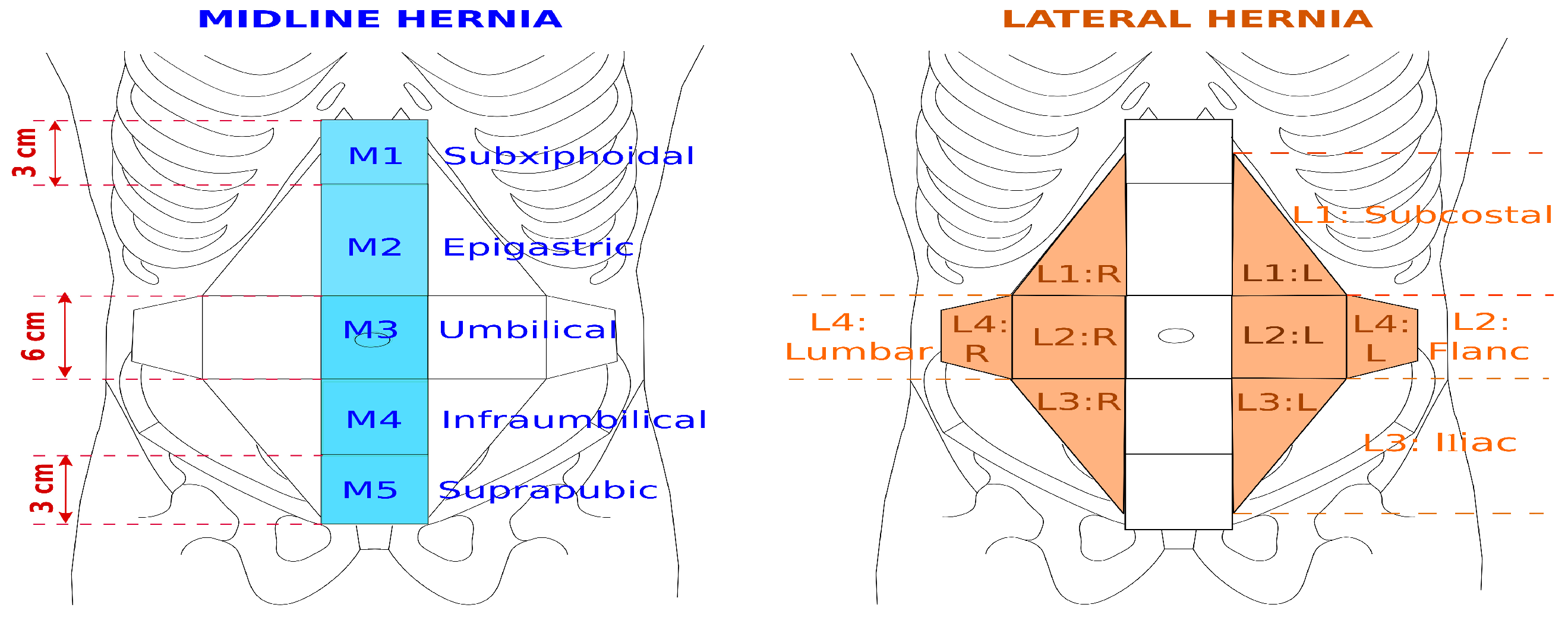
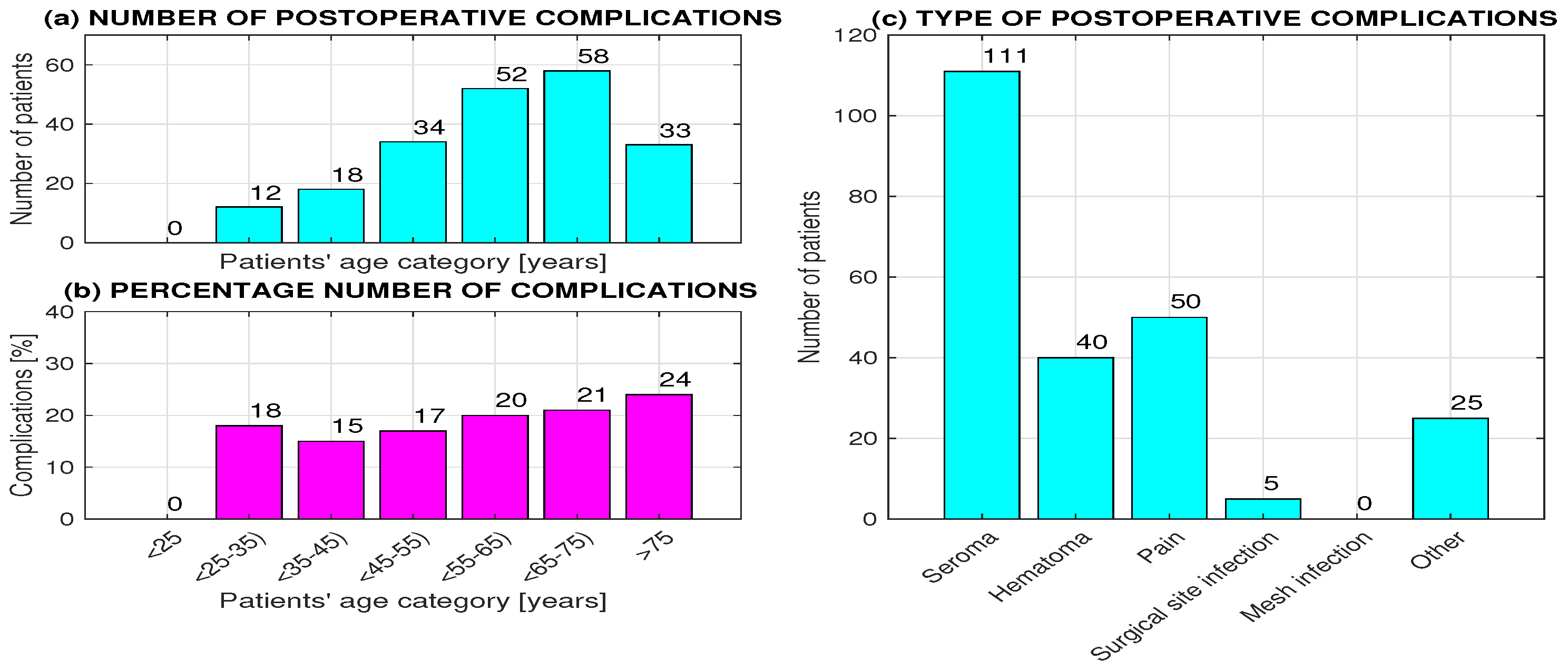

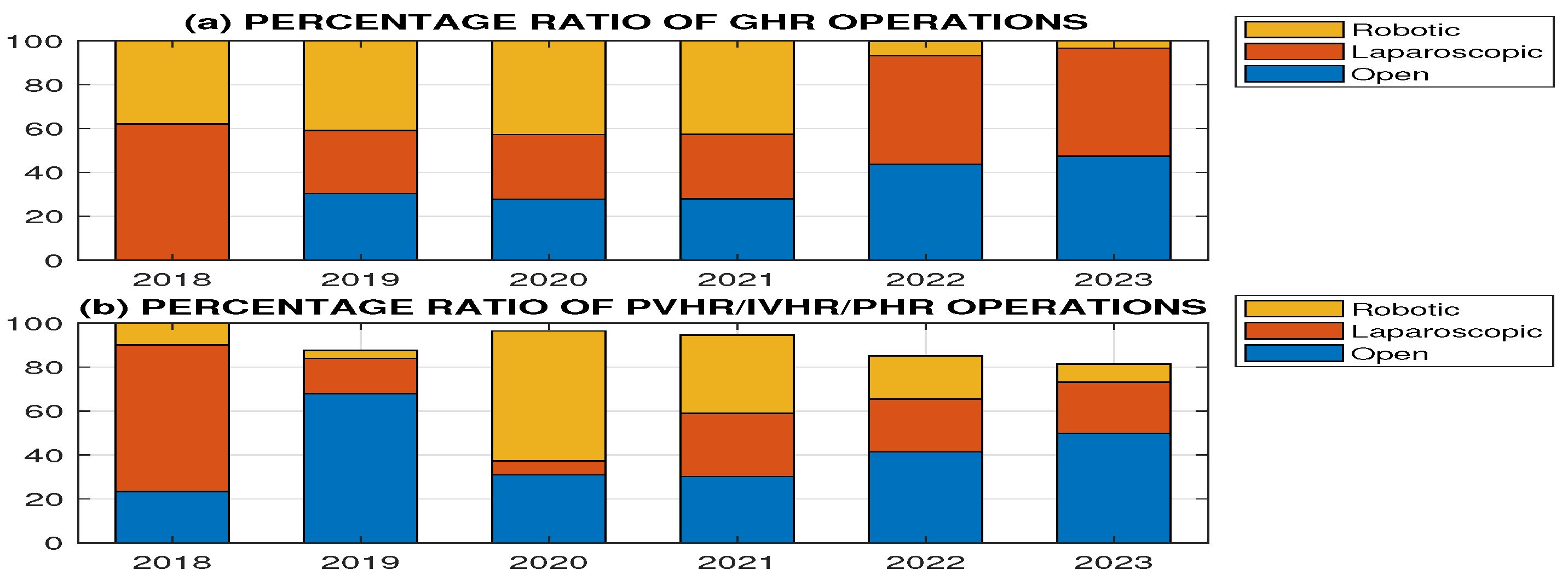

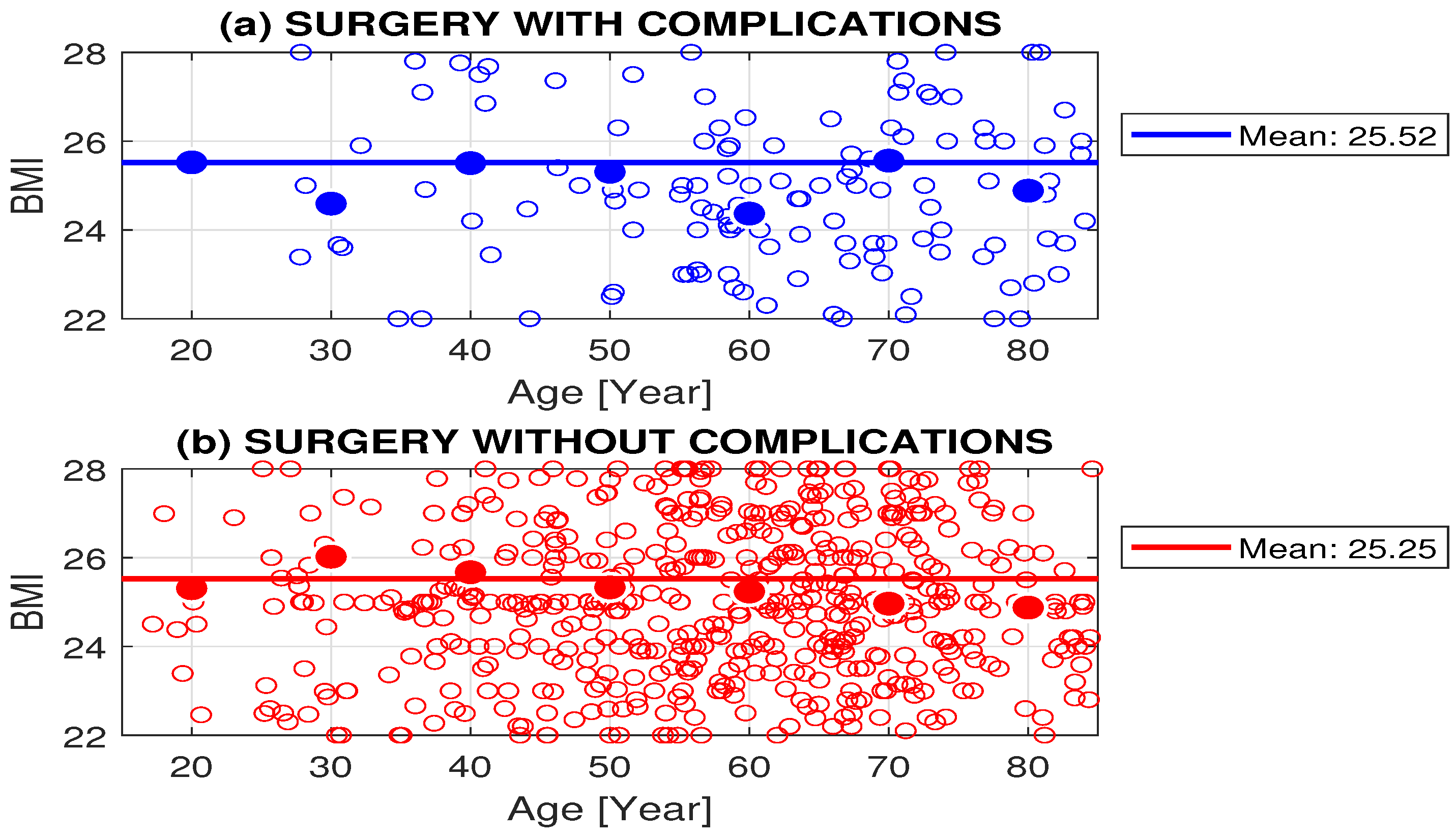
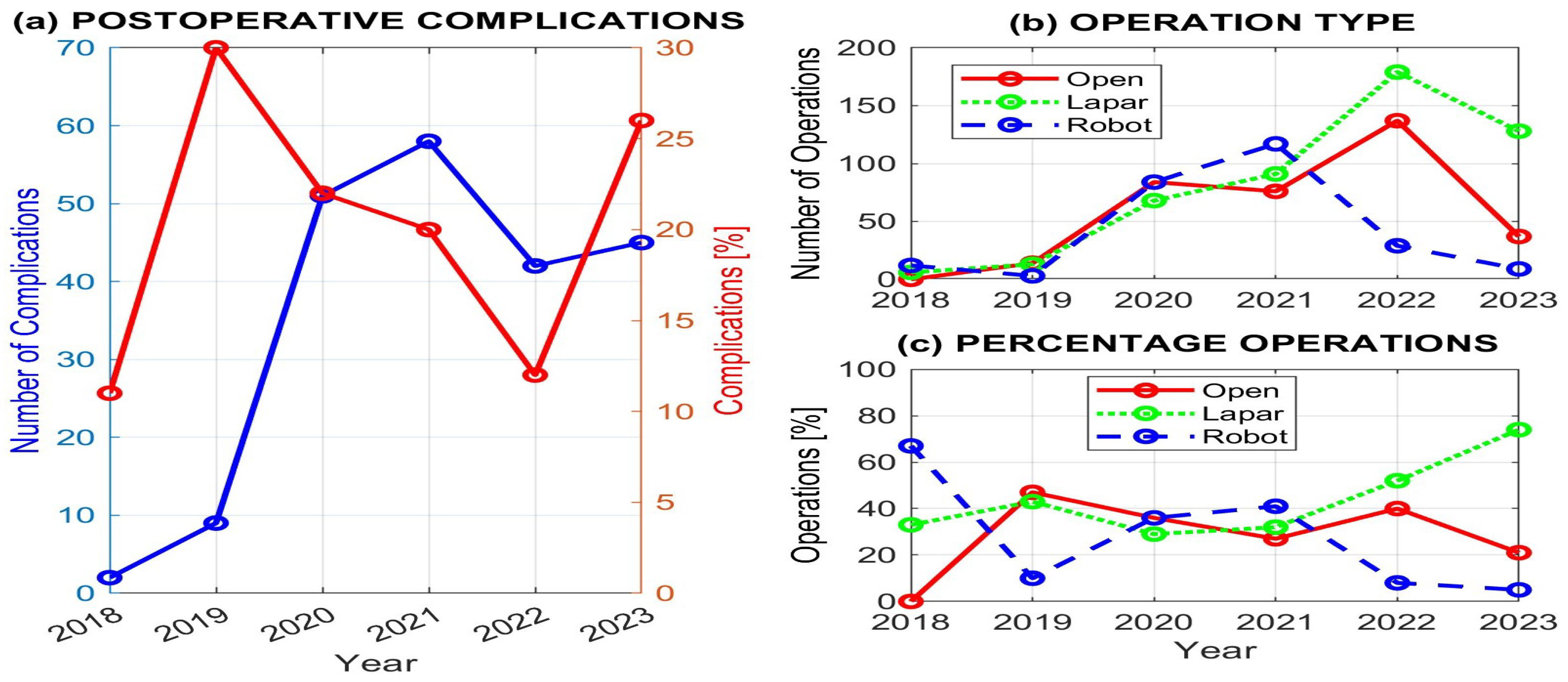
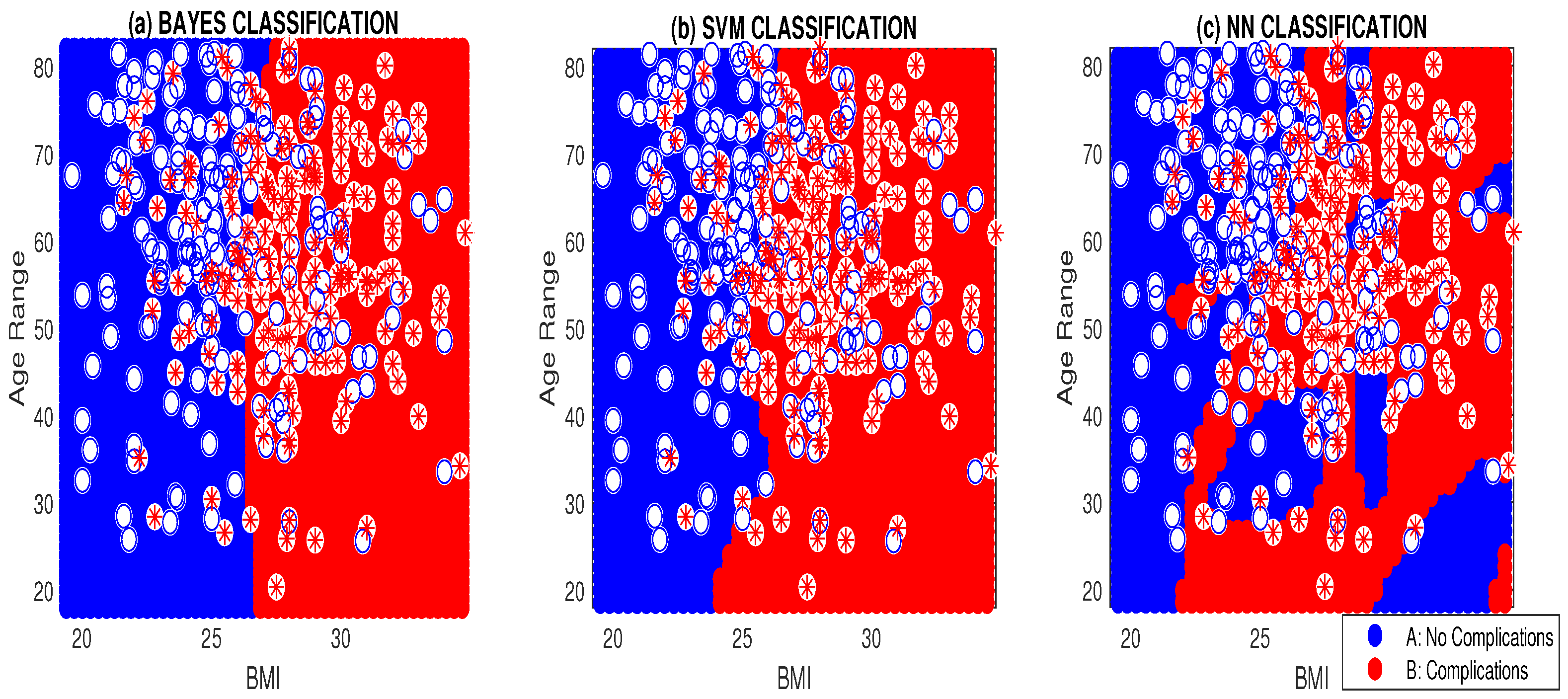
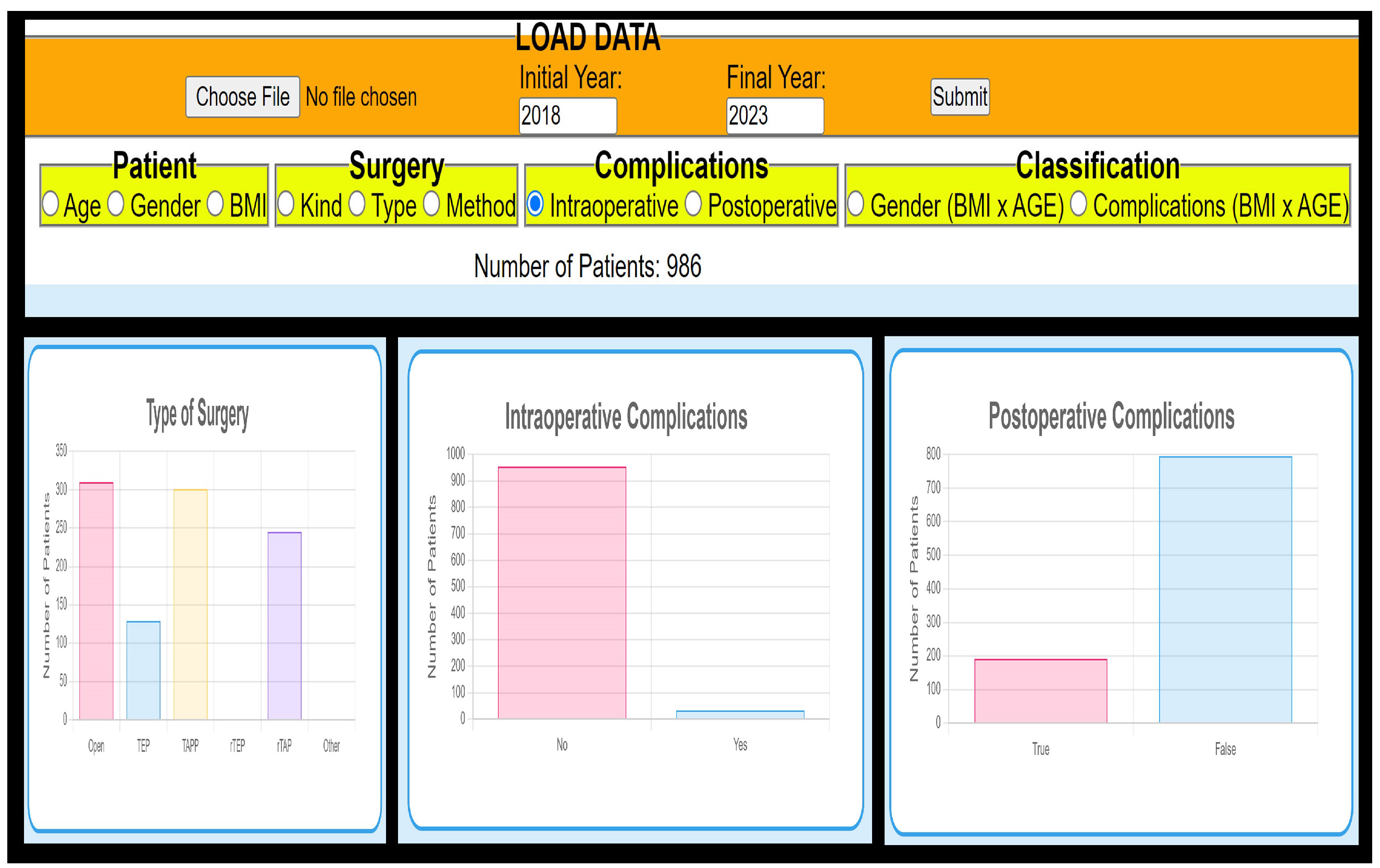
| Number of Patients | |||
|---|---|---|---|
| Age | Male | Female | Sum |
| <25 | 39 | 7 | 46 |
| 152 | 56 | 208 | |
| 283 | 123 | 406 | |
| 544 | 141 | 685 | |
| 641 | 142 | 783 | |
| 577 | 198 | 775 | |
| >75 | 324 | 112 | 436 |
| Sum | 256 | 779 | 3339 |
| Year | GHR | PVHR/IVHR/PHR | UNSPECIFIED | Total | |||||
|---|---|---|---|---|---|---|---|---|---|
| Male | Female | Sum | Male | Female | Sum | ||||
| 2012–2017 | 35 | 2 | 37 | 28 | 41 | 69 | 0 | 106 | |
| 2018 | 34 | 3 | 37 | 15 | 15 | 30 | 0 | 67 | |
| 2019 | 54 | 12 | 66 | 22 | 33 | 55 | 1 | 122 | |
| 2020 | 279 | 37 | 316 | 117 | 99 | 216 | 4 | 536 | |
| 2021 | 396 | 41 | 437 | 190 | 166 | 356 | 8 | 801 | |
| 2022 | 572 | 43 | 615 | 144 | 137 | 281 | 14 | 910 | |
| 2023 | 495 | 45 | 540 | 135 | 92 | 227 | 30 | 797 | |
| Sum | 1865 | 183 | 2048 | 651 | 583 | 1234 | 57 | 3339 | |
| Year | Type of Repair | Repair Technology | ||||
|---|---|---|---|---|---|---|
| Open | Endoscopic | Robotic | Other | Sum | ||
| 2012–2017 | GHR | 0 | 37 | 0 | 0 | 37 |
| PVHR/IVHR/PHR | 3 | 66 | 0 | 0 | 69 | |
| Sum | 3 | 103 | 0 | 0 | 106 | |
| 2018 | GHR | 0 | 23 | 14 | 0 | 37 |
| PVHR/IVHR/PHR | 7 | 20 | 3 | 0 | 30 | |
| Sum | 7 | 43 | 17 | 0 | 67 | |
| 2019 | GHR | 20 | 19 | 27 | 0 | 66 |
| PVHR/IVHR/PHR | 38 | 9 | 2 | 7 | 56 | |
| Sum | 58 | 28 | 29 | 7 | 122 | |
| 2020 | GHR | 88 | 93 | 135 | 0 | 316 |
| PVHR/IVHR/PHR | 68 | 14 | 130 | 8 | 220 | |
| Sum | 156 | 107 | 265 | 8 | 536 | |
| 2021 | GHR | 122 | 129 | 186 | 0 | 437 |
| PVHR/IVHR/PHR | 109 | 104 | 128 | 23 | 364 | |
| Sum | 231 | 233 | 314 | 23 | 801 | |
| 2022 | GHR | 269 | 304 | 41 | 1 | 615 |
| PVHR/IVHR/PHR | 122 | 71 | 58 | 44 | 295 | |
| Sum | 391 | 375 | 99 | 45 | 910 | |
| 2023 | GHR | 256 | 266 | 18 | 0 | 540 |
| PVHR/IVHR/PHR | 128 | 60 | 21 | 48 | 257 | |
| Sum | 384 | 326 | 39 | 48 | 797 | |
| SUM | GHR | 755 | 871 | 421 | 1 | 2048 |
| PVHR/IVHR/PHR | 475 | 344 | 342 | 127 | 1291 | |
| TOTAL SUM | 1230 | 1215 | 763 | 128 | 3339 | |
| Classification Method | AC | TNR | TPR | CV | |
|---|---|---|---|---|---|
| [%] | [%] | [%] | |||
| Bayes method | 68.2 | 70.6 | 65.9 | 0.31 | |
| SVM method | 70.1 | 61.7 | 78.4 | 0.30 | |
| NN method | 74.4 | 72.4 | 77.7 | 0.25 |
Disclaimer/Publisher’s Note: The statements, opinions and data contained in all publications are solely those of the individual author(s) and contributor(s) and not of MDPI and/or the editor(s). MDPI and/or the editor(s) disclaim responsibility for any injury to people or property resulting from any ideas, methods, instructions or products referred to in the content. |
© 2024 by the authors. Licensee MDPI, Basel, Switzerland. This article is an open access article distributed under the terms and conditions of the Creative Commons Attribution (CC BY) license (https://creativecommons.org/licenses/by/4.0/).
Share and Cite
Charvátová, H.; East, B.; Procházka, A.; Martynek, D.; Gonsorčíková, L. Computational Analysis and Classification of Hernia Repairs. Appl. Sci. 2024, 14, 3236. https://doi.org/10.3390/app14083236
Charvátová H, East B, Procházka A, Martynek D, Gonsorčíková L. Computational Analysis and Classification of Hernia Repairs. Applied Sciences. 2024; 14(8):3236. https://doi.org/10.3390/app14083236
Chicago/Turabian StyleCharvátová, Hana, Barbora East, Aleš Procházka, Daniel Martynek, and Lucie Gonsorčíková. 2024. "Computational Analysis and Classification of Hernia Repairs" Applied Sciences 14, no. 8: 3236. https://doi.org/10.3390/app14083236
APA StyleCharvátová, H., East, B., Procházka, A., Martynek, D., & Gonsorčíková, L. (2024). Computational Analysis and Classification of Hernia Repairs. Applied Sciences, 14(8), 3236. https://doi.org/10.3390/app14083236








